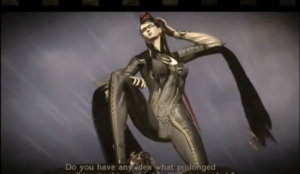Bayonetta is a game targeted towards those that enjoy action-adventure games, especially that emphasize combat, character-centric narratives, fans of anime and this style of visuals, etc. It was created by PlatinumGames and originally released for PlayStation 3 and Xbox 360 in 2009. It has since been re-released on multiple platforms, including PlayStation 4, Xbox One, and Nintendo Switch, making it accessible to a wide range of players.
Long story short, Bayonetta, has been both praised for its empowering protagonist and criticized for its sexualized portrayal of women. This commentary aims to delve into the feminist discourse surrounding the game, analyzing its strengths and weaknesses in the context of feminist theory. While Bayonetta presents a complex and powerful female lead, it also raises important questions about the perpetuation of objectification and gender stereotypes in the gaming industry.
Empowerment vs. Objectification
Bayonetta herself embodies a strong female protagonist, with outstanding combat skills and wit. She challenges traditional gender roles by showcasing her agency and autonomy throughout the game.
Bayonetta is far from a damsel in distress; instead, she embraces her sexuality and uses it as a weapon against her foes. This embodiment of female empowerment challenges the prevailing male-centric narratives often found in the gaming industry.
However, despite Bayonetta’s strength and independence, her design leans heavily into sexual objectification. Her appearance, characterized by revealing outfits and suggestive poses, arguably caters more to the male gaze than to female empowerment. This contradiction is an important point of analysis when considering the game’s feminist implications. She clearly looks drawn/designed by a male knowing his “gamer” audience. Also, there are sexual innuendos in Bayonetta’s dialogue, a more tame one includes, “I’m not going to stand here and lecture you because that’s not my style. But I know a good man when I see one, and I like what I see.”
She also frames herself as someone who is dangerous and can take care of herself through “”Don’t fuck with a witch.” This line highlights Bayonetta’s fearless attitude and her willingness to confront any challenge head-on. It reinforces her agency, further cementing her as a strong feminist protagonist.
Flaws and Clever Design Decisions
While Bayonetta’s character design may be a cause for concern, the game itself presents several interesting design choices that can be commended from a feminist perspective. One such decision is the absence of a male love interest, breaking away from the common trope of a female character’s worth being defined solely by her romantic relationships. Bayonetta’s motivations are not driven by the pursuit of a man but rather by her personal quest for self-discovery and vengeance.
Moreover, the game successfully subverts the traditional “damsel in distress” narrative by positioning Bayonetta as a formidable and independent force within the game world. She is never portrayed as weak or helpless, effectively challenging the notion that women in games must rely on men for their success.
This quote showcases Bayonetta’s agency and her refusal to conform to the expectations society may have of her. She defines her own standards for evaluating others, refusing to be a passive observer in her own story. She takes action!
Bayonetta is a game that both empowers and challenges feminist discourse. While its titular character breaks away from traditional gender roles and exhibits agency, the game’s sexualized portrayal of Bayonetta raises concerns about objectification. By analyzing the game through a feminist lens, we can appreciate the strides it makes in empowering women in gaming while also acknowledging the need for more nuanced and diverse representations of femininity in the industry. Bayonetta serves as a starting point for a broader conversation about gender representation in games, inspiring future designers to push the boundaries of traditional narratives and create more inclusive and empowering gaming experiences.

Learning
For formal elements, there is a clear solution of her completing her journey with the various opponents. Some of the procedures add to the dilemma as well. Bayonetta as marked as this femme fatale cold character, but when she meets the child that calls her “Mommy” her empathy grows, in contrast to her previous aesthetic of only allowing Bayonnetta to act selfishly for players. The aesthetics of fantasy and narrative go hand-in-hand with the mysterious Bayonnetta. The dynamic of darker situations creates an aesthetic of mystic and discovery as well.
For playing as a game designer, this game was not too difficult to observe while experiencing. I noted everytime I observed a major emotion, i.e. when she showed empathy for the child, breaking down the invincible persona. Additionally, a first order optimal strategy in the game was listening to the dialogue in its entirety.


